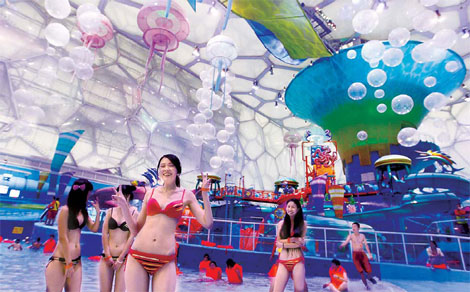Olympic venues revamp to attract visitors
(China Daily)
Updated: 2010-08-10 09:26
 |
Large Medium Small |

Water Cube reopens to public (Video)
The National Stadium and the National Aquatics Center - popularly known as Bird's Nest and the Water Cube - are being held up as examples to the world of the correct way to run Olympic facilities after the competition is over, despite concerns over the maintenance costs.
According to Li Aiqing, chairman of the Beijing State-owned Assets Management Company, both facilities are running well with a positive cash flow two years after the Beijing Olympics ended.
He was speaking during the 2010 Beijing Olympic City Development Forum on Monday, a gathering of representatives from Olympic host cities during which they shared best practices. Between October 2008 and July, the Bird's Nest saw more than 13 million visitors and took 550 million yuan in revenue, said Li. The Water Cube was also doing well before it was closed for renovations in October. Li said it saw five million visitors and took 150 million yuan in revenue.
During the hot summer weather, both venues have been flourishing, he said. The Water Cube is seeing between 10,000 and 14,000 visitors a day, thanks to several added activities introduced following its reopening on July 28.
"On one side, a children's area has been opened and, on the other, they are organizing a classical concert," said Henk Markerink, director of the European branch of the International Association of Assembly Managers, after he saw the facility.
Markerink said he was impressed by the creative way Beijing had used the Olympic venues, especially after having seen many Olympic sites used for the Athens Games standing empty.
Following the lead of the Water Cube, Li said the Bird's Nest will also be renovated and have more activities added. But, unlike the Water Cube, Li said the renovation of the Bird's Nest will happen in stages with the facility remaining open to the public while work continues.
In addition to renovations, Li said both places will invest heavily in bringing in live shows and sports events in a bid to attract audiences.
"Money put into these facilities is money from the people so you must have a good plan to explain to the people that you have done the right investment," Markerink said, adding that the world still has a number of "white elephants", a term he used to describe sports facilities built for big events that are wasted after the events end.
Previous bad experiences and Beijing's example have together prompted London to focus on how it will deal with its Olympic legacy.
London, probably for the first time in history, has already set up a company, three years before the Olympic Games will start, to focus on what will happen after the closing ceremony.
Karen Webb, the executive director of the marketing and communications department of the Olympic Legacy Company in London, said managing the legacy of the 2012 Games was central to London winning the bid.
To better exploit that legacy, the company is planning a regeneration project that is considered to be the most important of its kind in London for 25 years and one of the largest regeneration projects in Europe.
Under that project, London will be developing, starting in 2013, different levels of family housing, using a blending of the best of London's traditional housing with a unique access to sporting facilities, said Webb.
The ultimate goal, she said, is to create a signature destination and a great venue. "We need to have a highly active park, one that is primarily a center for the enjoyment of sports, culture and recreation," she said.